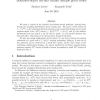106 search results - page 8 / 22 » Proving Lower Bounds Via Pseudo-random Generators |
ML
2002
ACM
13 years 7 months ago
2002
ACM
We examine linear program (LP) approaches to boosting and demonstrate their efficient solution using LPBoost, a column generation based simplex method. We formulate the problem as...
CORR
2002
Springer
13 years 7 months ago
2002
Springer
Different types of two- and three-dimensional representations of a finite metric space are studied that focus on the accurate representation of the linear order among the distance...
COCO
2003
Springer
14 years 21 days ago
2003
Springer
We study the complexity of building pseudorandom generators (PRGs) with logarithmic seed length from hard functions. We show that, starting from a function f : {0, 1}l → {0, 1} ...
ECCC
2010
13 years 7 months ago
2010
We study a variant of the classical circuit-lower-bound problems: proving lower bounds for sampling distributions given random bits. We prove a lower bound of 1 - 1/n(1) on the st...
JCO
2008
13 years 7 months ago
2008
The problem of partitioning a partially ordered set into a minimum number of chains is a well-known problem. In this paper we study a generalization of this problem, where we not ...

